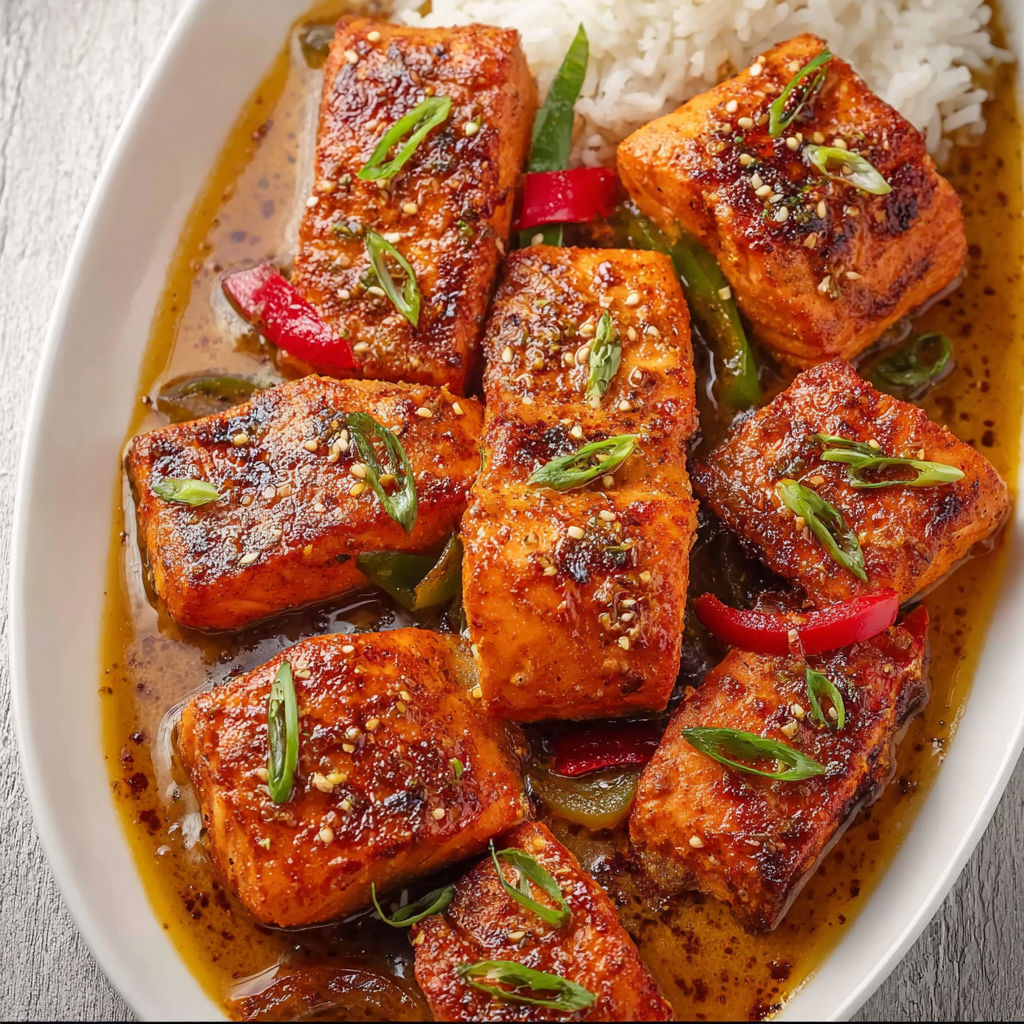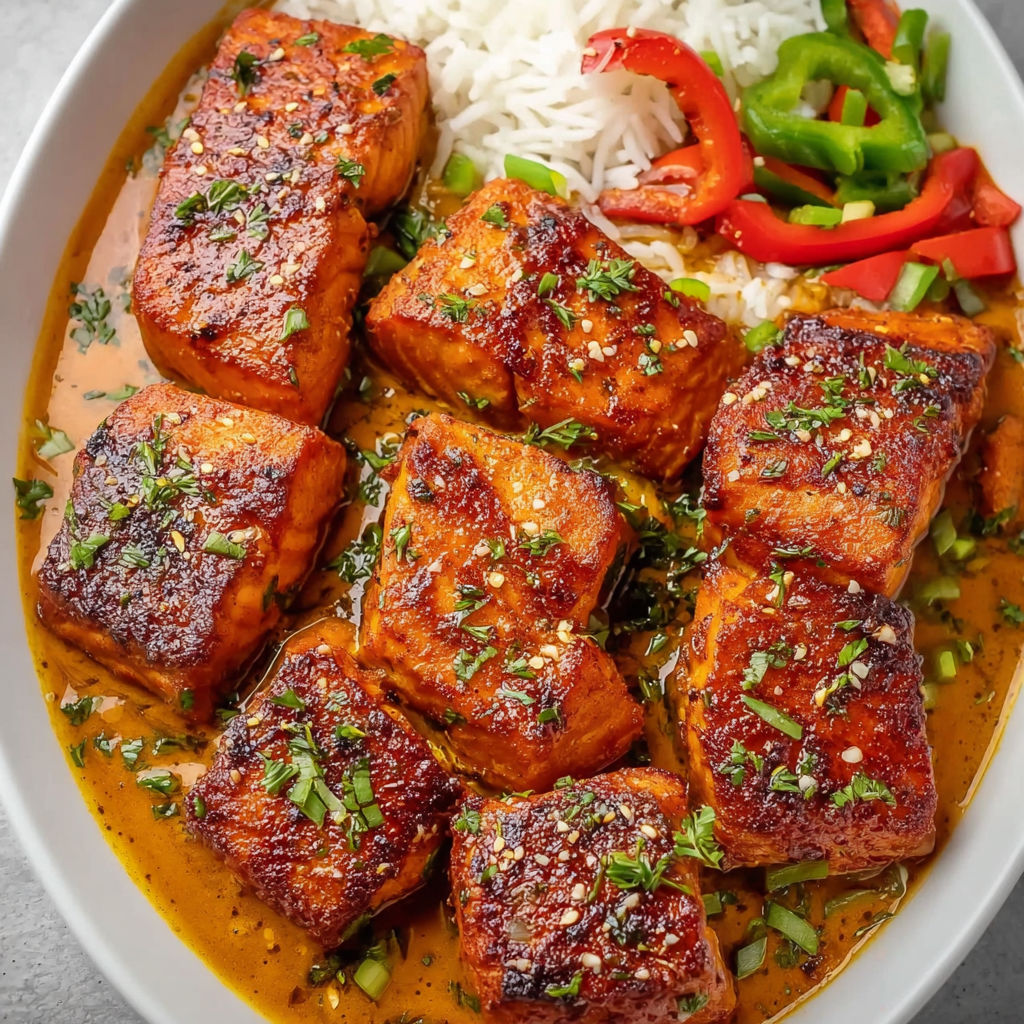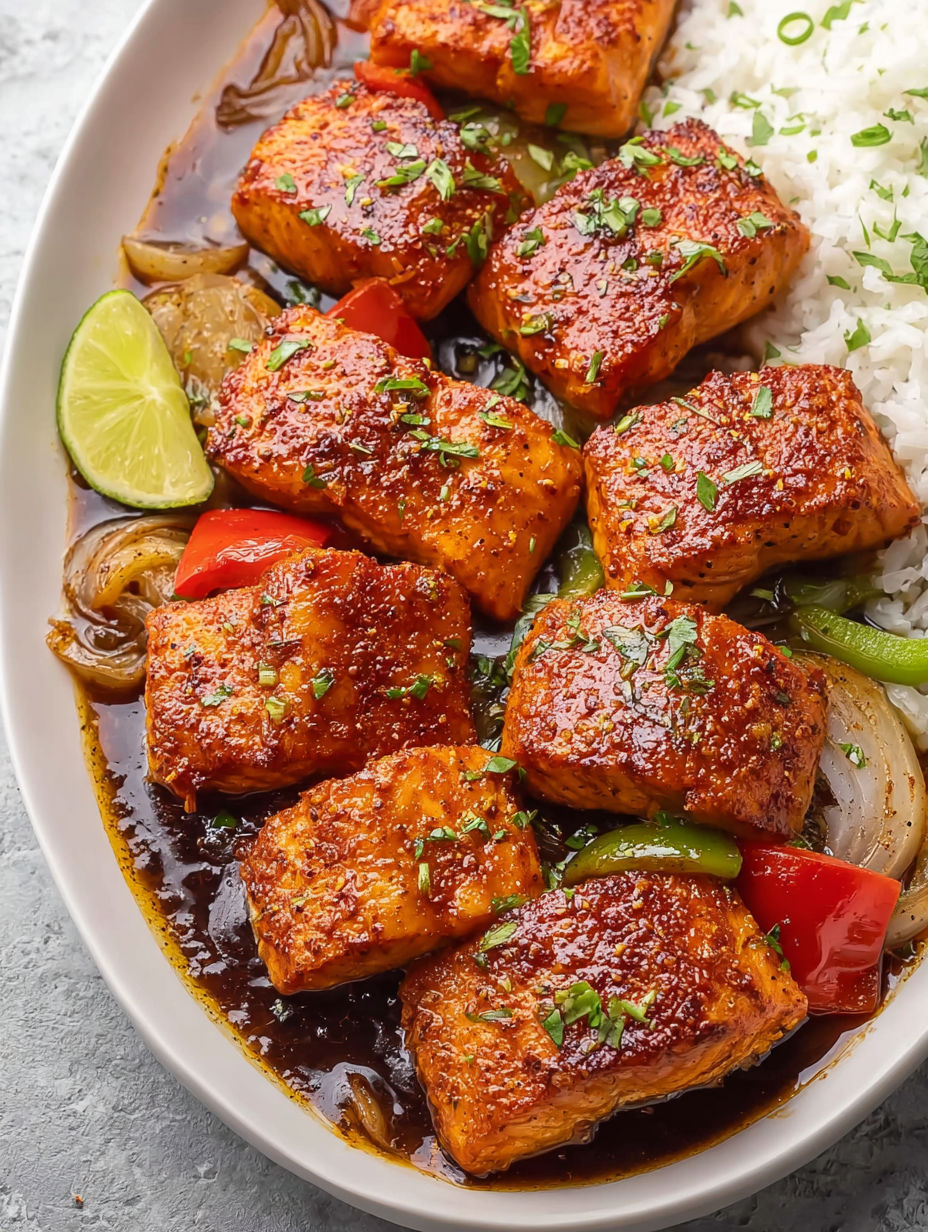 Pin
Pin
This vibrant Caribbean-Style Coconut Curry Salmon brings island flavors right to your dinner table with minimal effort. The richness of coconut milk paired with aromatic curry spices creates a sauce so good you'll want to drink it straight from the skillet.
I first made this dish when craving something different from our usual salmon routine. After one bite, my family declared it an instant favorite, and now it appears on our table at least twice a month.
- Salmon fillets Fresh, wild-caught salmon provides the best flavor and texture for this dish
- Curry powder Caribbean-style curry powder brings authentic island flavor with its unique blend of turmeric, coriander, and fenugreek
- Coconut milk Full-fat version creates a lusciously creamy sauce that perfectly balances the spices
- Bell peppers Add sweetness, color, and texture to complement the rich sauce
- Fresh thyme Essential for authentic Caribbean flavor with its earthy, slightly floral notes
- Scotch bonnet pepper Adds gentle heat without overwhelming when left whole in the sauce
- Garlic and ginger Fresh aromatics that form the flavor foundation of any good curry
- Jamaican allspice Brings warm, complex notes that are quintessentially Caribbean
How To Make Caribbean-Style Coconut Curry Salmon
- Season the salmon
- Combine curry powder, garlic powder, smoked paprika, salt, and pepper in a small bowl. Drizzle olive oil over salmon fillets and generously coat with the spice mixture, rubbing it in thoroughly to ensure every bite is flavorful. Allow the salmon to sit briefly while you prepare your pan.
- Sear to perfection
- Heat oil in a large skillet until shimmering. Place seasoned salmon in the hot pan and resist the urge to move it for 2-3 minutes. This patience creates that beautiful golden crust that adds texture and seals in moisture. Flip once and cook just until your desired doneness, then set aside.
- Bloom the curry
- This step is magic. Sprinkle curry powder into hot oil and stir continuously as it darkens and becomes intensely aromatic. This process, called blooming, activates the essential oils in the spices, transforming their flavor from flat to fantastic. It only takes about 30 seconds but makes all the difference.
- Build the sauce
- Add butter, peppers, and onions to the pan, sautéing until softened but still vibrant. Introduce garlic, ginger, thyme, and allspice, stirring until the kitchen fills with an intoxicating aroma. Pour in coconut milk and add the whole scotch bonnet for gentle heat that infuses rather than overwhelms.
- Reunite and simmer
- Return the seared salmon to the skillet, nestling it into the simmering sauce. Spoon the curry over the fillets, allowing the flavors to meld for just a minute or two. The salmon will finish cooking gently in the sauce, remaining perfectly tender.
My absolute favorite part of this dish is how the salmon absorbs the curry sauce while still maintaining its distinct flavor. The first time I served this to my Caribbean friend, she closed her eyes and said it reminded her of home. That moment cemented this recipe as a special one in my collection.
The Art of Curry Blooming
Blooming your curry powder in hot oil is the secret technique that elevates this dish from good to extraordinary. This brief cooking of dry spices awakens dormant flavors and transforms them into something richer and more complex. When you see the curry powder darken slightly and smell its intensified aroma, you know you've done it right. Never skip this step, even if you're tempted to save time.
Perfect Pairings
This coconut curry salmon begs to be served over a bed of fluffy jasmine rice that will soak up every drop of the precious sauce. For a complete meal, add steamed baby bok choy or green beans on the side. The vegetables provide a fresh contrast to the rich curry. A side of fried plantains offers a traditional Caribbean sweet counterpoint that complements the savory salmon beautifully.

Storing and Reheating
This curry actually improves with time as the flavors meld together. Store leftovers in an airtight container in the refrigerator for up to three days. When reheating, do so gently over low heat to preserve the texture of the salmon. Add a splash of coconut milk if the sauce has thickened too much. Avoid microwaving if possible as it can make the salmon tough and overcooked.
Smart Substitutions
No Caribbean curry powder? Use standard Madras curry powder mixed with a pinch of allspice and extra turmeric. Scotch bonnet peppers can be replaced with habaneros or even a teaspoon of hot sauce added at the end. For a lighter version, light coconut milk works, though the sauce won't be quite as creamy. Salmon can be swapped for firm white fish like cod or even chicken thighs for a different spin.

Recipe FAQs
- → What can I substitute for Caribbean curry powder?
If you can't find Caribbean curry powder, you can substitute with a mix of standard curry powder, ground turmeric, ground coriander, and a pinch of ground allspice. Brands like Betapac or Chief are recommended, but you can also check international food sections in larger supermarkets or order online.
- → How do I know when the salmon is properly cooked?
Properly cooked salmon should flake easily with a fork but still maintain moisture. For medium doneness, the center should be slightly translucent. The searing time (2-3 minutes per side) typically yields medium-cooked salmon, but adjust according to thickness and preference.
- → Can I use light coconut milk instead of full-fat?
While you can use light coconut milk, full-fat coconut milk creates a richer, more authentic sauce. Light coconut milk will produce a thinner consistency and less creamy flavor. For best results, stick with full-fat coconut milk.
- → What can I substitute for scotch bonnet pepper?
If scotch bonnet isn't available, habanero peppers make the closest substitute with similar heat levels. For less heat, try jalapeño or serrano peppers. Remember to keep the pepper whole and remove before serving. Alternatively, add a dash of hot sauce to taste after cooking.
- → What sides pair well with Caribbean coconut curry salmon?
Jasmine rice is ideal for absorbing the flavorful sauce. Other excellent pairings include coconut rice, roti, plantains, steamed vegetables, or a fresh cucumber salad. For a lower-carb option, try cauliflower rice or a bed of sautéed greens.
- → Can I make this dish ahead of time?
The coconut curry sauce can be made 1-2 days ahead and refrigerated. When ready to serve, gently reheat the sauce and add freshly seared salmon. For best quality, cook the salmon just before serving as reheating can dry it out.
